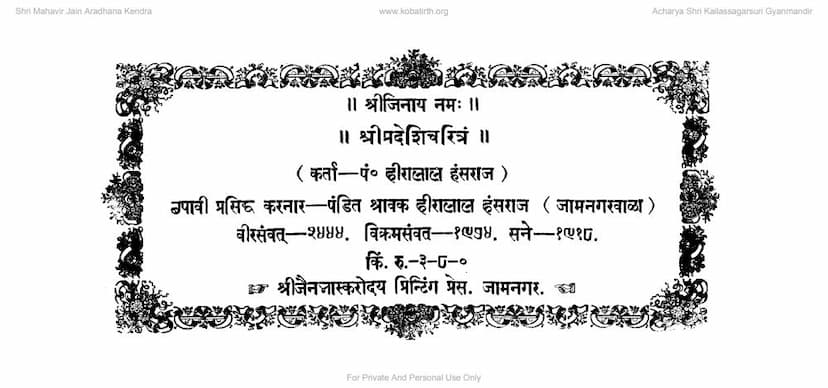Pradeshi Charitram
Added to library: September 2, 2025

Summary
Here's a comprehensive summary of the provided Jain text, "Pradeshi Charitram," by Shravak Hiralal Hansraj:
The text is a Jain religious narrative detailing the life and spiritual journey of King Pradeshi, his interactions with Lord Mahavir, and his eventual attainment of liberation. The work is presented in a poetic and devotional style, typical of Jain literature, and emphasizes the core principles of Jainism: non-violence, truthfulness, non-stealing, celibacy (or chastity), and non-possession, as well as the importance of right faith (Samyak Darshan) and righteous conduct.
Key Themes and Narrative Arc:
-
Invocation and Setting: The text begins with traditional invocations to Jain Tirthankaras and the author's spiritual guides. It then sets the scene in Jambudvipa, describing a prosperous and beautiful city where virtuous people live.
-
King Pradeshi's Ignorance and Cruelty: The narrative introduces King Pradeshi, who is depicted as a ruler engrossed in worldly pleasures, addicted to hunting, and causing suffering to his subjects and animals. He is characterized by ignorance of Jain philosophy and practices, displaying traits like cruelty, deceit, and attachment to sensual pleasures.
-
Encounter with Lord Mahavir: The central turning point in the story is Pradeshi's encounter with Lord Mahavir, the 24th Tirthankara. Despite his initial arrogance and skepticism, Pradeshi is drawn to the Lord's divine presence and teachings.
-
The Teachings of Lord Mahavir: Lord Mahavir delivers profound sermons on the transient nature of life, the suffering inherent in the cycle of birth and death (Samsara), the consequences of actions (Karma), and the path to liberation. The sermons cover various aspects of Jain philosophy, including the importance of:
- Right Faith (Samyak Darshan): Believing in the Tirthankaras and their teachings.
- Right Knowledge (Samyak Gyan): Understanding the true nature of reality.
- Right Conduct (Samyak Charitra): Practicing ethical principles and vows.
- The dangers of attachment, anger, ego, and deceit.
- The significance of non-violence (Ahimsa) towards all living beings.
- The impermanence of worldly possessions and relationships.
-
Pradeshi's Transformation: Through Lord Mahavir's teachings and the subsequent spiritual guidance from his disciples (like Keshikumara), King Pradeshi begins to shed his ignorance and destructive tendencies. He reflects on his past actions, realizes the futility of his cruel pursuits, and starts to embrace the Jain path.
-
The Stories of Devotion and Right Conduct (Examples): The text intersperses Pradeshi's story with illustrative narratives of individuals who exemplified Jain virtues. These include:
- Devapala: A humble cowherd who, through devotion to Jain idols and adherence to vows, rose to kingship and ultimately attained a heavenly existence.
- Parasurama: The son of a minister who, after initially stealing a valuable gem, repented, returned it, and ultimately achieved spiritual progress through upholding Jain vows.
- Surapriya: A virtuous prince who resisted the temptations of a forest deity and demonstrated unwavering chastity, leading to a heavenly rebirth.
- Rohini: The queen of King Ashokachandra, whose devotion and adherence to Jain practices led to the well-being of her children and her own elevated status.
- Vasumitra and his sons: A wealthy merchant family whose adherence to Jain principles, despite initial hardships and the wrong interpretation of scriptures by some, led to spiritual gains.
- Vasunarendra: A king who, despite being a proponent of truth, eventually fell due to the influence of falsehood and attachment, highlighting the dire consequences of deviating from righteousness.
-
The Journey to Liberation: Pradeshi, deeply influenced by the teachings and examples, renounces his former ways. He dedicates himself to the practice of Jainism, observing vows, practicing meditation, and showing compassion to all beings. The narrative culminates in his spiritual transformation and eventual attainment of liberation (Moksha).
-
Author's Devotion and Purpose: The author, Hiralal Hansraj, expresses deep devotion to Lord Mahavir and his lineage of gurus. He states his intention in writing this narrative is to provide spiritual guidance and happiness to the readers, reinforcing the importance of the Jain path for universal well-being.
Overall Message:
"Pradeshi Charitram" serves as a powerful moral and spiritual guide, illustrating the consequences of unrighteous living and the transformative power of Jain teachings. It emphasizes that true happiness and liberation are achieved through adherence to ethical principles, devotion to the Tirthankaras, and the pursuit of spiritual knowledge, rather than through worldly pleasures, power, or material wealth. The story of Pradeshi is a testament to the possibility of redemption and spiritual awakening, even for those who have strayed far from the path of righteousness.